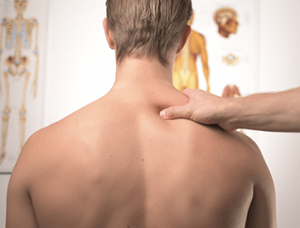Thoracic Outlet Syndrome
Thoracic Outlet Syndrome
A group of conditions that results from the compression of blood vessels or nerves in space between collarbone and first rib (thoracic outlet) is referred to as thoracic outlet syndrome. This leads to pain in shoulder and neck associated with numbness in fingers.
Symptoms
Thoracic outlet syndrome is of number of types such as:
- Neurological (neurogenic) thoracic outlet syndrome: most commonly occurring type, characterized by brachial plexus compression that controls shoulder, arm and hand’s muscles movements and sensations. Symptoms include:
- Gilliatt-Sumner hand i-e wasting of muscles in the bulky area of thumb.
- Tingling in arms and fingers
- Weak grip
- Pain in the shoulders, neck and arms
- Vascular thoracic outlet syndrome: occur due to compression of one or more arteries or veins under the collarbone. Symptoms include:
- Bluish discoloration of hand
- Pain and swelling of arm and hands
- Clotting of blood in the veins and arteries
- Cold fingers and arms
- Pallor fingers
- Fatigued arms
- Weak or no pulse in affected arm
- Near collarbone throbbing lump can be seen.
- Nonspecific-type thoracic outlet syndrome: This is also known as disputed thoracic outlet syndrome. Some physician don’t believe it exists while some believe it’s a common syndrome. In this chronic pain in the thoracic outlet is experiences but specific cause of pain can’t be determined.
Causes
Thoracic outlet syndrome is caused by the compression of veins and arteries in the thoracic outlet under clavicle. Main causes of compression are:
- Congenital anatomical defects
- Poor posture
- Traumatic event
- Repetitive activities
- Pressure on joints mainly due to oversized backpacks
- Pregnancy
Diagnosis
Diagnosis of this syndrome depends upon detailed medical history and complete general physical examination of the patient. Along with this other tests include:
- Some provocative tests
- Imaging tests like Xrays, ultrasound, CT scan, MRI, angiography, arteriography and venography.
- Electromyography (EMG) and nerve conduction study.
Treatment
Treatment options include the following:
- Physical therapies
- Medications like anti-inflammatory, analgesics, muscles relaxants and clot dissolving medications.
- Sometimes surgery is also needed in long standing cases.
Lifestyle and home remedies
- Try to maintain a good posture
- Move and stretch during work by taking short breaks
- Avoid lifting heavy backs on shoulder
- Avoid activities that trigger and worsen the pain
- Apply heating pad to the area to relieve stiffness and pain
